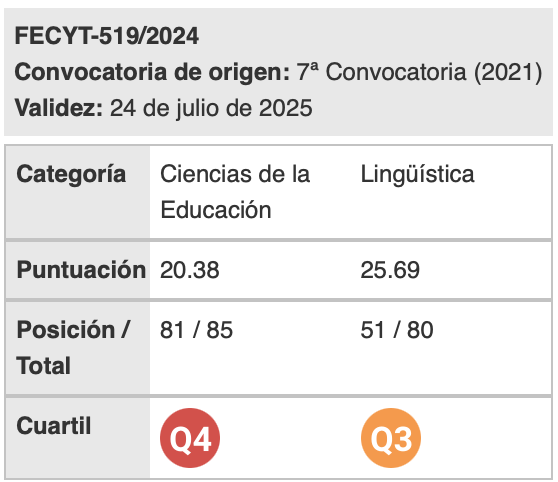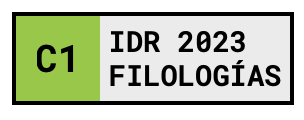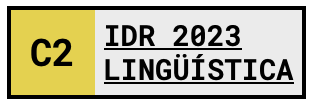An Account of English YES/NO Interrogative Sentences within ARTEMIS
Keywords:
Yes/No Interrogatives, Role and Reference Grammar, ARTEMISAbstract
As stated in Periñán-Pascual and Arcas Túnez (2010, p. 2671) FunGramKB´s lexical and grammatical levels are grounded in sound linguistic theories, allowing the system to capture syntactic-semantic generalizations which are able to provide both explanations and predictions of language phenomena. The linguistic foundation of FunGramKB is inspired on Role and Reference Grammar (RRG, Van Valin, 2005) and the Lexical Constructional Model (LCM, Ruíz de Mendoza & Mairal Usón, 2008; Mairal Usón & Ruíz de Mendoza, 2008). The close interrelation between these grammatical theories and FungramKB is patent in the design of ARTEMIS (Automatically Representing Text Meaning via an Interlingua-Based System”), an NLP system whose objective is the simulation of natural language understanding. In doing so, ARTEMIS becomes a development of the syntax-to-semantics linking algorithm proposed in RRG which involves a parsing process that starts with a natural language sentence, extracts its morphosyntactic features and provides a representation of these in terms of the so-called layered structure of the clause (LSC) in RRG. Because of its centrality, there is a vital need for a full development of ARTEMIS. This paper aims at contributing to this elaboration by proposing the set of rules and operations necessary for the treatment of Yes/No interrogative sentences within such an NLP system.Downloads
References
Cortés-Rodríguez, F. (2016a). Parsing simple clauses within ARTEMIS: The computational treatment of the layered structure of the clause in Role and Reference Grammar. 34th International Conference of AESLA. Alicante, 14-16, April 2016.
Cortés-Rodríguez, F. (2016b). Towards the computational implementation of Role and Reference Grammar: Rules for the syntactic parsing of RRG phrasal constituents. Círculo de Lingüística Aplicada a la Comunicación, 65, 75-108.
Cortés-Rodríguez, F. & Mairal-Usón, R. (2016). Building an RRG computational grammar. Onomázein 34, 86-117.
Díaz-Galán, A. & Fumero-Pérez, M.C. (2016). Developing parsing rules within ARTEMIS: the case of DO auxiliary insertion”. In C. Periñán-Pascual & E. Mestre i Mestre (Eds.), Understanding meaning and knowledge representation: From theoretical and cognitive linguistics to natural language processing (pp.283-302). Cambridge: Cambridge Scholars Press.
Mairal-Usón, R. & Ruiz de Mendoza Ibáñez, F. (2008). Levels of description and explanation in meaning construction. In Ch. Butler & J. Martín Arista (Eds.), Deconstructing Constructions (pp. 153–198). Amsterdam/Philadelphia: John Benjamins.
Periñán-Pascual, C. (2013). Towards a model of constructional meaning for natural language understanding. In B. Nolan & E. Diedrichsen (Eds.), Linking Constructions into Functional Linguistics: The role of constructions in grammar [Studies in Language Companion Series 145] (pp. 205–230). Amsterdam: John Benjamins
Periñán-Pascual, C. & Arcas-Túnez, F. (2010). The architecture of FungramKB. In Proceedings of the 7th International Conference on Language Resources and Evaluation, (pp. 2667-2674). Malta: European Language Resources Association (ELRA).
Periñan-Pascual, C. & Arcas-Túnez, F. (2014). The implementation of the FunGramKB CLS constructor, In B. Nolan & C. Periñán-Pascual (Eds.), Language Processing and Grammars (pp. 165-196). Amsterdam: John Benjamins.
Periñán-Pascual, C. & Mairal Usón, R. (2011). The COHERENT methodology in FunGramKB. Onomázein 24, 13-33.
Quirk, R., Greenbaum S., Leech, G. & Svartvik, J. (1985). A comprehensive grammar of the English language. London: Longman.
Ruiz de Mendoza Ibáñez, F. & Mairal-Usón, R. (2008). Levels of description and constraining factors in meaning construction: an introduction to the Lexical Constructional Model. Folia Linguistica 42(2), 355-400.
Sag, I. A., Wasow, T. & Bender, E. M. (2003). Syntactic theory: Formal introduction. Stanford: Center for the Study of Language and Information (CSLI) Publications.
Van Valin, R. D., Jr. (2005). Exploring the syntax-semantics interface. Cambridge: Cambridge University Press.
Van Valin R.D. Jr. & LaPolla, R. (1997). Syntax: Structure, meaning and function. Cambridge: Cambridge University Press.
Downloads
Published
How to Cite
Issue
Section
License
Authors who publish with this journal agree to the following terms:
- Authors retain copyright and grant the journal right of first publication with the work simultaneously licensed under a Creative Commons Attribution License that allows others to share the work with an acknowledgement of the work's authorship and initial publication in this journal.
- Authors are able to enter into separate, additional contractual arrangements for the non-exclusive distribution of the journal's published version of the work (e.g., post it to an institutional repository or publish it in a book), with an acknowledgement of its initial publication in this journal.
- Authors are permitted and encouraged to post their work online (e.g., in institutional repositories or on their website) prior to and during the submission process, as it can lead to productive exchanges, as well as earlier and greater citation of published work (See The Effect of Open Access).

Revista de Lenguas para fines específicos is licensed under a Creative Commons Reconocimiento-NoComercial-SinObraDerivada 4.0 Internacional License.
























